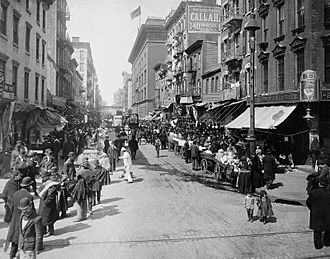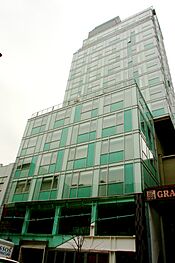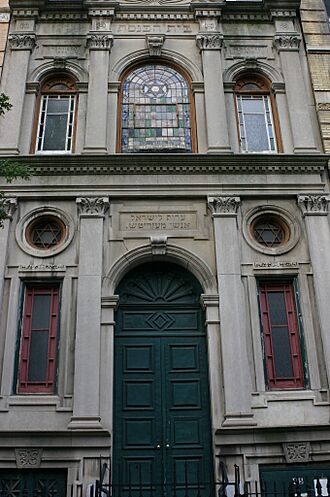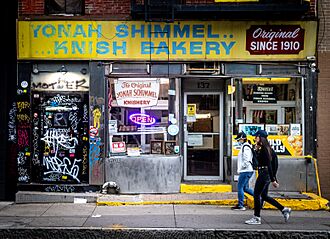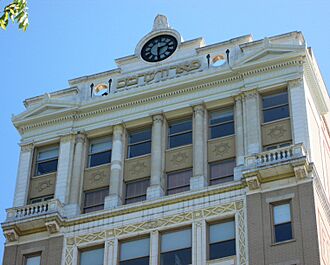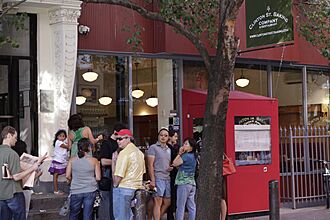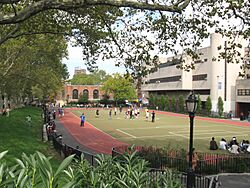Lower East Side facts for kids
Quick facts for kids
Lower East Side
|
|
|---|---|

The corner of Orchard and Rivington Streets in the Lower East Side in 2005
|
|
| Country | |
| State | |
| City | New York City |
| Borough | Manhattan |
| Community District | Manhattan 3 |
| Area | |
| • Total | 2.17 km2 (0.837 sq mi) |
| Population
(2010)
|
|
| • Total | 72,957 |
| • Density | 33,655/km2 (87,160/sq mi) |
| Ethnicity | |
| • Hispanic | 39.6% |
| • Asian | 24.9% |
| • White | 22.6% |
| • Black | 10.9% |
| • Other | 2.0% |
| Economics | |
| • Median income | $51,649 |
| Time zone | UTC−05:00 (Eastern) |
| • Summer (DST) | UTC−04:00 (EDT) |
| ZIP Codes |
10002
|
| Area code | 212, 332, 646, and 917 |
|
Lower East Side Historic District
|
|
| Location | Roughly bounded by East Houston, Essex, Canal, Eldridge, South, and Grand Streets, and the Bowery and East Broadway, Manhattan, New York (original) Roughly along Division, Rutgers, Madison, Henry and Grand Streets (increase) |
| NRHP reference No. | 00001015 (original) 04000297 (increase) |
| Added to NRHP | September 7, 2000 (original) May 2, 2006 (increase) |
The Lower East Side, also known as LES, is a very old neighborhood in the southeastern part of Manhattan in New York City. It is located between the Bowery and the East River, from Canal Street to Houston Street. For a long time, it was known as a place where many immigrants and working-class families lived.
In the mid-2000s, the neighborhood started to change a lot. Newer, wealthier people began moving in, which is called gentrification. This led the National Trust for Historic Preservation to list it as one of America's Most Endangered Places in 2008.
The Lower East Side is part of Manhattan Community District 3. Its main ZIP Code is 10002. The New York City Police Department's 7th Precinct patrols the area.
Neighborhood Boundaries
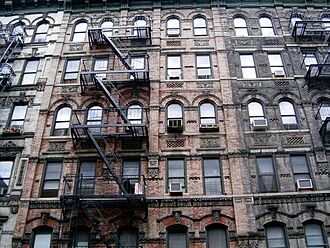
The Lower East Side has changed its boundaries over time. Today, it is generally bordered by East 14th Street to the north and the East River to the east. To the south, it reaches Fulton and Franklin Streets. To the west, it is bordered by Pearl Street and Broadway.
This larger area includes other well-known neighborhoods like Chinatown, the East Village, and Little Italy. A smaller definition of the Lower East Side would have it bordered by Chinatown to the south and west. Nolita is to its west, and the East Village is to its north.
Historically, the "Lower East Side" covered a wider area along the East River. It stretched from the Manhattan Bridge and Canal Street up to 14th Street. Its western border was roughly Broadway. This older definition included places now called East Village, Alphabet City, Chinatown, Bowery, Little Italy, and NoLIta. Some parts of the East Village are still known as Loisaida, which is how some Latino people pronounce "Lower East Side."
A Look at Lower East Side History
Early Days Before Europeans Arrived
Like all of Manhattan Island, the Lower East Side was once home to the Lenape tribe. These Native Americans lived in groups that moved with the seasons. They fished in the rivers during summer. In fall and winter, they moved inland to gather food and hunt. Their main path followed what is now Broadway. One of their camps in the Lower East Side area was called Rechtauck or Naghtogack.
First European Settlements

The first Dutch settlers in New Amsterdam mostly lived south of today's Fulton Street. North of that area were small farms called "bouwerij" (which means "bowery"). Around these farms, some free or "half-free" African people lived. They created a buffer zone between the Dutch settlers and the Native Americans. One of the biggest of these settlements was along the modern Bowery. These black farmers were among the very first people to settle in this area.
Over time, in the 1600s, these farms became larger pieces of land. Much of the Lower East Side became part of the Delancey farm.
James Delancey owned a large farm before the American Revolution. This farm was east of the main road leading from the city, which was the Bowery. You can still see his influence in street names like Delancey Street and Orchard Street. Delancey planned a large square called Delancey Square. It was supposed to be where Eldridge, Essex, Hester, and Broome Streets are today. But after the American Revolution, the Delancey family lost their land. The city then created a grid of streets instead of the planned square.
Corlears Hook
The piece of land on the East River now called Corlears Hook was also known as Corlaers Hook by the Dutch and British. It was named after Jacobus van Corlaer, a schoolmaster who settled there in 1638.
In 1833, Corlear's Hook became home to some of the first tenement buildings in New York City. These were crowded apartment buildings for many families.
The writer Herman Melville mentioned Corlears Hook in his famous book Moby Dick. He wrote about walking from Corlears Hook to Coenties Slip.
Today, the original Corlears Hook is hidden by land added to the shoreline. It was near the east end of the pedestrian bridge over the FDR Drive. The name lives on in Corlears Hook Park along the East River Drive.
A Century of Immigration
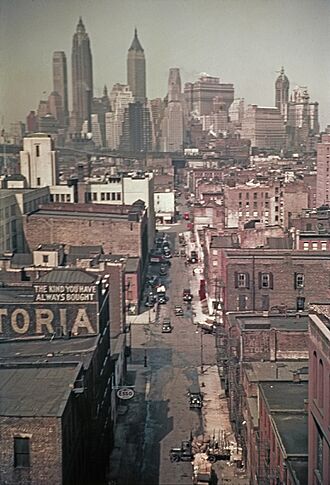
In the late 1800s and early 1900s, many immigrants arrived in New York City. Most of them moved into the crowded tenements of the Lower East Side. By the 1840s, many German immigrants settled here. A large part of the area became known as "Little Germany" or "Kleindeutschland."
Later, groups from Eastern Europe, like Jews, Italians, Poles, and Hungarians, also moved in. Each group often settled in its own part of the neighborhood. By 1920, the Jewish community was very large, with 400,000 people. Pushcart vendors and shops filled Orchard and Grand Streets. Many Yiddish theatres were on Second Avenue.
Living conditions in these crowded areas were tough. However, new laws helped by requiring "new law" tenements to have air shafts. This allowed fresh air and some light into each apartment. People like Jacob Riis, who wrote How the Other Half Lives, worked to improve things. They set up settlement houses, like the Henry Street Settlement, to help families. The city also built First Houses in 1935–1936. This was the first public housing project in the United States.
The 20th Century and Beyond
By the early 1900s, the Lower East Side was known for its strong political ideas. Many popular performers, like Eddie Cantor and George and Ira Gershwin, grew up here. Later, artists and writers were drawn to the area because housing and food were cheap.
After World War II, the Lower East Side became New York City's first neighborhood with many different races living together. African Americans and Puerto Ricans moved in. Areas where Spanish was spoken a lot began to be called Loisaida.
By the 1960s, many Jewish and Eastern European residents had moved away. The Lower East Side then faced a time of "ongoing poverty, crime, and empty buildings." A big part of the neighborhood was planned for demolition to build new housing. But this plan faced a lot of opposition from the community and was never fully carried out.
East Village Changes and Modern Growth
The East Village used to be seen as part of the Lower East Side. But in the 1960s, more artists and musicians moved into the area above Houston Street. Newcomers and real estate agents started using the name East Village. Soon, the two areas were seen as separate neighborhoods.
By the 1980s, the Lower East Side started to get better. It began to attract students, artists, and middle-class people. Immigrants from places like Taiwan, China, and the Dominican Republic also moved in.
In the early 2000s, the changes seen in the East Village spread to the Lower East Side. It became one of Manhattan's most fashionable neighborhoods. Orchard Street, once known for bargains, now has fancy shops. Trendy restaurants, like Clinton St. Baking Company & Restaurant, opened on Clinton Street. New York Magazine called it the "hippest restaurant row."
In 2007, the Blue Condominium, a tall luxury building, was finished. Its modern design looks very different from the older buildings around it. This new construction, along with the Hotel on Rivington and the New Museum on Bowery, shows that the neighborhood is becoming more upscale.
More recently, these changes have moved south of Delancey Street. Many new restaurants, bars, and art galleries have opened. The Blue Moon Hotel, another boutique hotel, opened in 2006. It used an existing tenement building, keeping its original look. In 2013, the Essex Crossing project was announced. This large redevelopment will bring new buildings to the area, mostly south of Delancey Street.
Population and People
The Lower East Side's population was 72,957 in 2010. This was a small increase from 2000. The neighborhood covers about 0.837 square miles.
In 2010, the people living here were:
- 39.6% Hispanic or Latino
- 24.9% Asian
- 22.6% White
- 10.9% African American
- 2.0% Other races
Between 2000 and 2010, the number of White and Asian residents increased. The number of Hispanic/Latino residents decreased.
The average life expectancy in this area is 82.2 years. Most people are adults, with 35% aged 25–44. About 18% of residents live in poverty. The average household income in the Lower East Side was $51,649 in 2017.
Neighborhood Culture
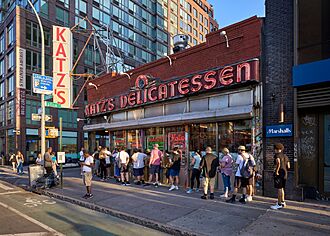
A Place for Immigrants
The Lower East Side is one of New York City's oldest neighborhoods. It has always been a place for working-class people. It has been home to many different ethnic groups. In the past, there were many Germans, and it was called Little Germany. There were also many Irish, Italians, Poles, and Ukrainians.
Today, it is mainly a Puerto Rican and Dominican community. The neighborhood is also changing due to gentrification.
For many years, the Lower East Side was a major center for Jewish immigrant culture. You can still find signs of this history in shops on Hester and Essex Streets. An Orthodox Jewish community still lives here. They have schools and a mikvah (a Jewish ritual bath). Some Jewish shops and kosher style delis, like the famous Katz's Deli, are still in the neighborhood.
Second Avenue was once known as “Yiddish Broadway.” It had many Yiddish theatre productions in the early 1900s. Famous people like Irving Berlin and John Garfield grew up here.
Since the mid-1900s, many immigrants from Latin America have moved to the area. They have opened their own grocery stores and shops. Bodegas have replaced many Jewish shops. Most residents are now Roman Catholics.
In the East Village, new immigrants have replaced older Polish and Ukrainian groups. Many Japanese people have moved in, leading to more Japanese restaurants. There are also many Bangladeshis and other immigrants from Muslim countries. They attend the small Madina Masjid, a mosque on First Avenue.
Chinese residents have also been moving into the Lower East Side. The part of the neighborhood south of Delancey Street has become part of Chinatown. Grand Street is a main shopping street for Chinatown.
Jewish Heritage Sites
Many American Jews feel a strong connection to the Lower East Side. It was a starting point for many of their families. Over the years, Jewish communities have worked to save historic buildings.
Some notable Jewish heritage sites include:
- The Educational Alliance Settlement house – 175 East Broadway
- Henry Street Settlement – 263–267 Henry Street
- University Settlement House – 184 Eldridge Street
- Katz's Deli – 205 East Houston Street
- Guss' Pickles – 87 Orchard Street
- Kossar's Bialys – 367 Grand Street
- Yonah Schimmel's Knish Bakery – 137 East Houston Street
- Mendel Goldberg Fabrics, since 1890 – 72 Hester Street
- Harris Levy Fine Linens, since 1894 – 98 Forsyth Street
- Russ & Daughters – 179 East Houston Street
- Forward Building – 173-175 East Broadway
- Jarmulowsky Bank Building – 54-58 Canal Street
Important Synagogues include:
- Bialystoker Synagogue – 7–11 Willet Street, built in 1826
- Beth Hamedrash Hagadol – 60–64 Norfolk Street
- Eldridge Street Synagogue – 12 Eldridge Street
- Kehila Kedosha Janina – 280 Broome Street (the only Greek synagogue in the Western Hemisphere)
- Angel Orensanz Center – one of the oldest synagogue buildings in the United States
- Meseritz Synagogue – 415 East 6th Street
- Stanton Street Synagogue – 180 Stanton Street
Little Fuzhou in Chinatown
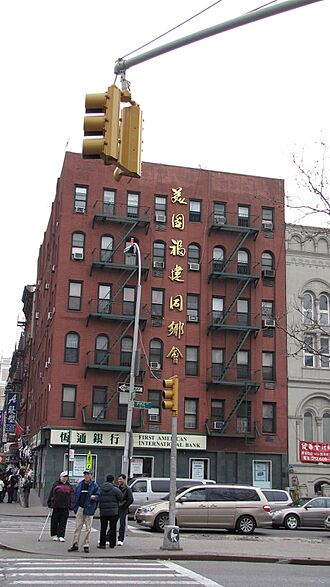
Little Fuzhou is a neighborhood within the eastern part of Chinatown. It is in the Two Bridges and Lower East Side areas. Starting in the 1980s, it became a main place for immigrants from Fuzhou, Fujian, China. Manhattan's Little Fuzhou is centered on East Broadway.
However, since the 2000s, Chinatown, Brooklyn has become the new main place for Fuzhou immigrants. This new Little Fuzhou is much bigger. Manhattan's Little Fuzhou is shrinking due to gentrification. This means more wealthy, often non-Chinese, people are moving in. They are also opening high-end businesses.
Art and Creativity
The Lower East Side has many contemporary art galleries. One of the first was ABC No Rio. This gallery was started by artists who wanted to involve the community. They encouraged creating art that was not just for selling. This approach led to new kinds of art.
Many other galleries opened in the Lower East Side and East Village. In 2007, the New Museum moved to a new building on Bowery. More galleries are opening nearby to be close to the museum. The Museum of Reclaimed Urban Space, which opened in 2012, shows photos of the neighborhood. It also tells the story of its history of community action.
Organizations like Henry Street Settlement and Educational Alliance have art programs. The Abrons Arts Center is a place for modern art. The neighborhood is also known for graffiti artists like Chico and Jean-Michel Basquiat.
Nightlife and Music Scene
As the neighborhood has become more modern and safer, it is now a popular place for evening activities. Streets like Orchard, Ludlow, and Essex are very busy at night. This can cause noise issues between businesses and long-time residents. Also, as the area changes, some old landmarks and music venues have closed.
The Lower East Side has many places for live music. Bowery Ballroom on Delancey Street and Mercury Lounge on East Houston Street host alternative rock bands. Otto's Shrunken Head and R-Bar are known for punk bands. Bowery Electric is also a popular spot. Some bars, like Pianos on Ludlow Street and Arlene's Grocery on Stanton Street, also offer performance spaces.
The Lower East Side is home to the Slipper Room. This theater hosts burlesque, variety, and vaudeville shows. Famous artists like Lady Gaga and U2 have appeared there.
Safety and Services
The Lower East Side is protected by two New York City Fire Department (FDNY) fire stations:
- Engine Company 15/Ladder Company 18/Battalion 4 – 25 Pitt Street
- Engine Company 9/Ladder Company 6 – 75 Canal Street
The neighborhood uses the ZIP Code 10002. The United States Postal Service has two post offices here:
- Knickerbocker Station – 128 East Broadway
- Pitt Station – 185 Clinton Street
Learning and Education

The Lower East Side has many residents who have gone to college. About 48% of adults aged 25 and older have a college degree or higher. This is more than the average for New York City.
Students in the Lower East Side do well in school. Math scores for elementary students went from 61% in 2000 to 80% in 2011. Reading scores also improved. Fewer elementary students miss school here compared to the rest of the city. Also, 77% of high school students graduate on time.
Local Schools
The New York City Department of Education runs public schools in the Lower East Side. Students living in this area can apply to any school in Community School District 1.
Some public elementary schools (grades PK-5) in the Lower East Side are:
- New Explorations Into Science Tech and Math (NEST+m) (grades K-12)
- PS 1 Alfred E Smith
- PS 2 Meyer London
- PS 20 Anna Silver
- PS 42 Benjamin Altman
- PS 110 Florence Nightingale
- PS 134 Henrietta Szold
- PS 142 Amalia Castro
Elementary/middle schools (grades PK-8) include:
- PS 126 Jacob August Riis
- PS 140 Nathan Straus
- PS 184 Shuang Wen
- PS 188 The Island School
Middle and high schools in the Lower East Side are:
- Orchard Collegiate Academy (grades 9–12)
- School for Global Leaders (grades 6–8)
- University Neighborhood Middle School (grades 5–8)
- University Neighborhood High School (grades 9-12)
The Lower East Side Preparatory High School (LESPH) and Emma Lazarus High School (ELHS) help older students (17–21) earn their high school diplomas. LESPH is a bilingual Chinese-English school. ELHS focuses on English-immersion for a diverse group of students.
The Seward Park Campus has five schools. Their average graduation rate is about 80%.
Public Libraries
The New York Public Library (NYPL) has two branches in the Lower East Side. The Seward Park branch is at 4192 East Broadway. It opened in 1909. The Hamilton Fish Park branch is at 415 East Houston Street. It was rebuilt in 1960.
Parks and Green Spaces
The Lower East Side has private parks like La Plaza Cultural. There are also public parks in the area. These include Sara D. Roosevelt Park between Chrystie and Forsyth Streets. Seward Park is on Essex Street.
The John V. Lindsay East River Park runs along the waterfront. It stretches from East 12th Street to Montgomery Street. A new section, Pier 42, is planned to open in 2021.
Getting Around: Transportation
The Lower East Side has several New York City Subway stations. These include Grand Street, Bowery, Second Avenue, Delancey Street–Essex Street, and East Broadway.
Many New York City Bus routes serve the neighborhood. These include the M9, M14A SBS, M14D SBS, M15, M15 SBS, M21, M22, M103, and B39.
The Williamsburg Bridge and Manhattan Bridge connect the Lower East Side to Brooklyn. The FDR Drive runs along the neighborhood's south and east sides.
As of 2018, about 37% of the roads in the Lower East Side have bike lanes. You can find bike lanes on streets like Allen, Chrystie, Clinton, Delancey, and Houston. There are also bike lanes on the Williamsburg and Manhattan bridges. The East River Greenway is also available for bikes.
The Lower East Side also has NYC Ferry service. The South Brooklyn route stops at Corlears Hook in the East River Park. Ferry service started there on August 29, 2018.
Famous People From the Lower East Side
- Adrienne Bailon (born 1983), TV personality and singer
- George Barris (1922–2016), photographer
- Sy Berger (1923–2014), baseball card designer
- Mark Bloch (born 1956), artist and writer
- Joseph B. Bloomingdale (1842–1904), businessman
- Lyman G. Bloomingdale (1841–1905), businessman
- George Burns (1896–1996), comedian and actor
- James Cagney (1899–1986), actor and dancer
- Sammy Cahn (1913–1993), songwriter
- Michael Che (born 1983), comedian and writer
- Joshua Lionel Cowen (1877–1965), inventor
- Jimmy Durante (1893–1980), comedian and singer
- Miriam Friedlander (1914–2009), politician
- Lady Gaga (born 1986), singer and actress
- John Garfield (1913–1952), actor
- Ben Gazzara (1930–2012), actor
- George Gershwin (1898–1937), composer
- Lotti Golden (born 1949), singer-songwriter
- Marcus Goldman (1821–1904), banker
- Ralph Goldstein (1913–1997), Olympic fencer
- Ruby Goldstein (1907–1984), boxer and referee
- Samuel Gompers (1850–1924), labor union leader
- David Gordon (1936–2022), dancer and choreographer
- Rocky Graziano (1919–1990), boxer and actor
- Samuel Greenberg (1893–1917), poet
- David Greenglass (1922–2014), machinist
- Sally Gross (1933–2015), dancer and choreographer
- Luis Guzmán (born 1956), actor
- Maggie Gyllenhaal (born 1977), actress
- Yip Harburg (1896–1981), song lyricist
- Lazarus Joseph (1891–1966), lawyer and politician
- Jane Katz (born 1943), educator and Olympic swimmer
- Jack Kirby (1917–1994), comic book artist
- LA II (born 1967), graffiti artist
- Fiorello LaGuardia (1882–1947), attorney and politician
- Emanuel Lehman (1827–1907), businessman
- Henry Lehman (1822–1855), businessman
- Mayer Lehman (1830–1897), businessman and philanthropist
- Saul Leiter (1923–2013), photographer
- Melissa Leo (born 1960), actress
- Sidney Lumet (1924–2011), film director
- Madonna (born 1958), singer and actress
- Joseph Mankiewicz (1909–1993), film director
- Jackie Mason (1931–2021), comedian and actor
- Walter Matthau (1920–2000), actor
- Julia Migenes (born 1949), singer
- Zero Mostel (1915–1977), actor and comedian
- Jim Neu (1943–2010), playwright
- Mikhail Odnoralov (1944–2016), artist
- Charlie Parker (1920–1955), jazz saxophonist
- Genesis P-Orridge (1950–2020), singer-songwriter
- Lee Quiñones (born 1960), artist and actor
- Lou Reed (1942–2013), musician and songwriter
- Edward G. Robinson (1893–1973), actor
- Sonny Rollins (born 1930), jazz saxophonist
- Joseph Seligman (1819–1880), banker
- Sheldon Silver (1944–2022), politician
- Al Singer (1909–1961), boxer
- Mose Solomon (1900–1966), baseball player
- David South, musician and filmmaker
- John Spacely (died 1993), musician and actor
- Ysanne Spevack (born 1972), composer
- Johnny Thunders (1952–1991), guitarist and singer
- Rachel Trachtenburg (born 1993), musician and singer
- Luther Vandross (1951–2005), singer and songwriter
- B. D. Wong (born 1960), actor
- Christopher Woodrow (born 1977), entrepreneur and movie producer
See also
 In Spanish: Lower East Side para niños
In Spanish: Lower East Side para niños


